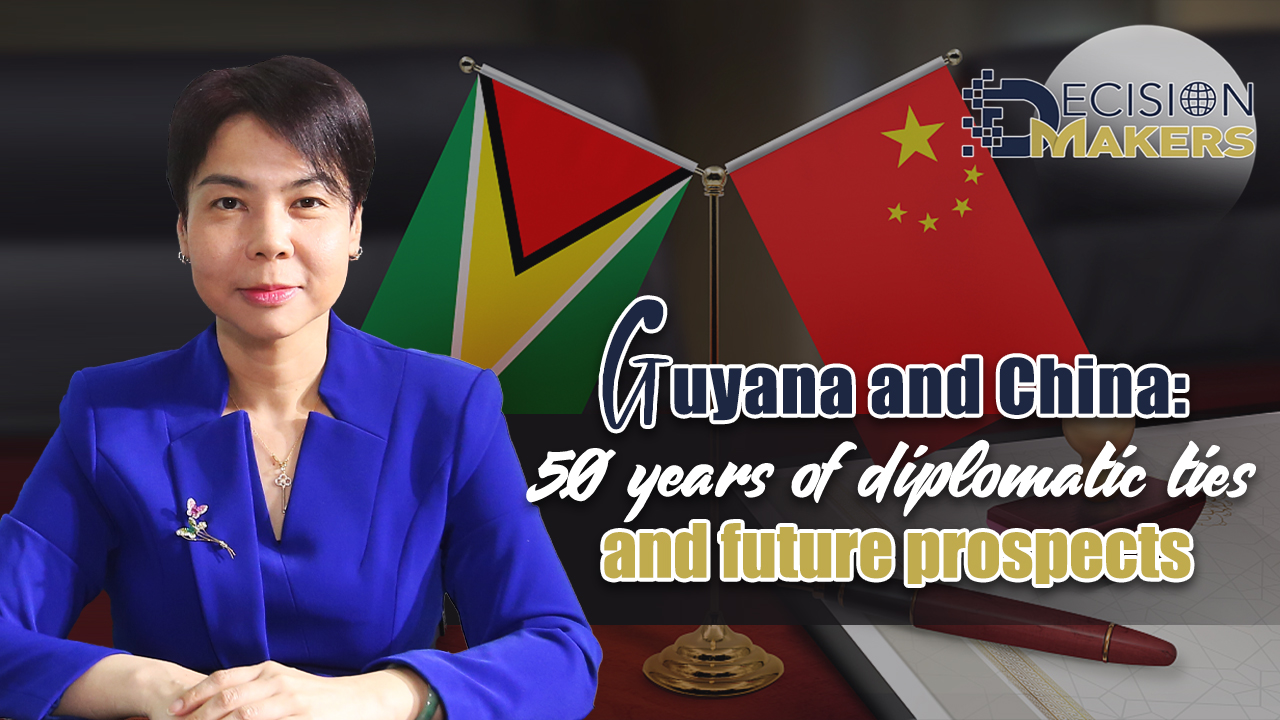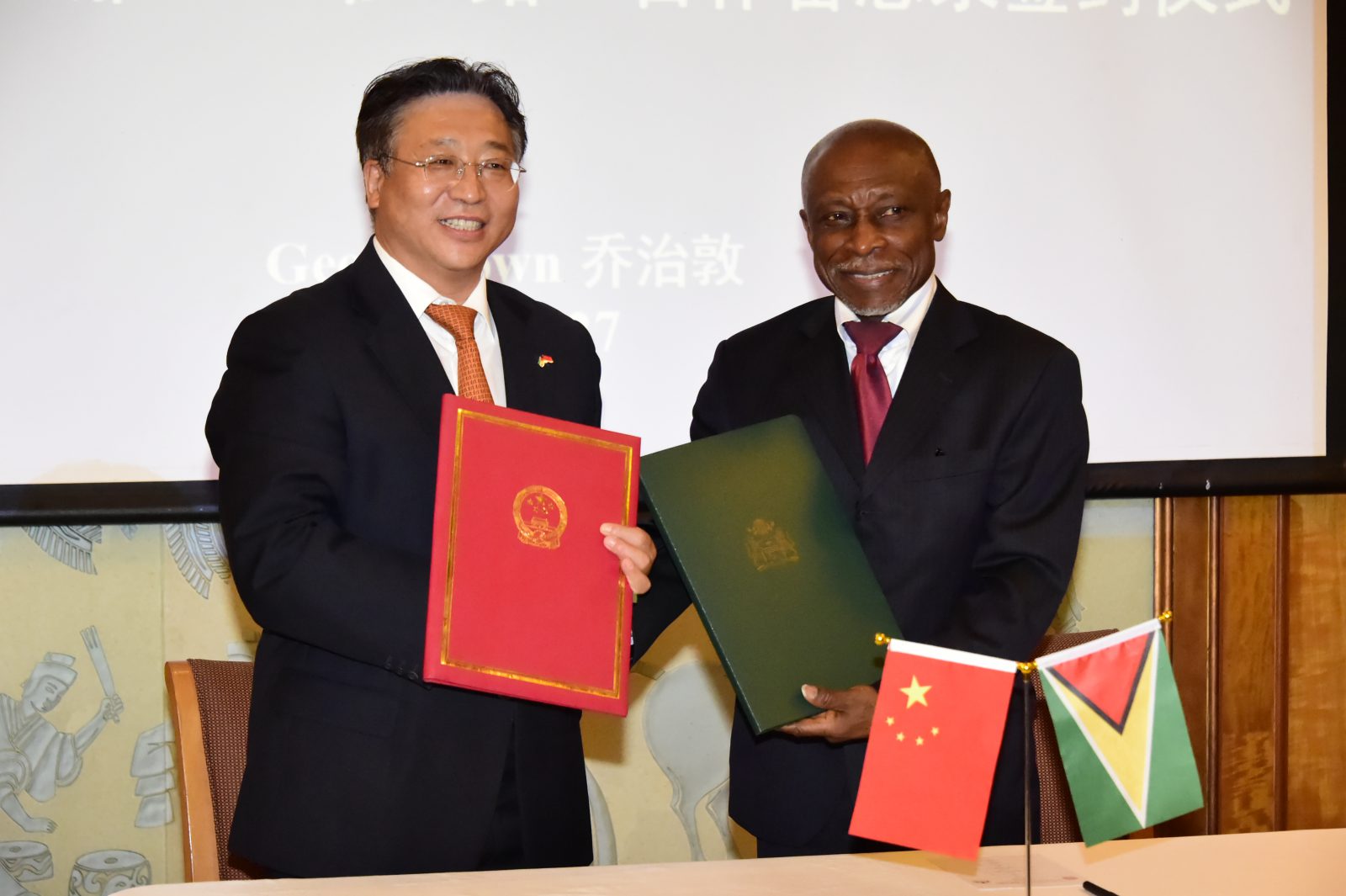
Editor's note: Decision Makers is a global platform for decision makers to share their insights on events shaping today's world. Anyin Choo is Guyana's Ambassador Extraordinary and Plenipotentiary to China. The article reflects the author's opinions and not necessarily the views of CGTN.
Guyana's relations with China pre-dates the formal establishment of diplomatic ties on June 27, 1972, and commenced with the arrival of the first group of Chinese migrants to the country in 1853, and was cemented in October, 1971, when Guyana voted in favor of the People's Republic of China as the legal representative of China at the United Nations. Guyana opened its Embassy in Beijing in 1973, making it the first country among the English-speaking Caribbean countries to establish a diplomatic mission in China.
Our bilateral relations with China have been premised on the recognition of the "One China" policy. This year marks the 50th anniversary of the establishment of diplomatic ties with China and the Guyanese attaching significance to this historic relationship. Over the last five decades, both sides have witnessed official exchange visits at the highest levels, cultural exchange groups, visits by political and friendship delegations, support for each other in the areas of mutual interest and benefits, cooperation in the medical fields and increase in trade and investments.
Guyana signed a Memorandum of Understanding (MoU) for cooperation on the Belt and Road Initiative (BRI) on July 27, 2018, and this has strengthened the foundation for expansion of bilateral relations between Guyana and China, making cooperation in the areas of policy coordination, facilities connectivity, trade and investment, finance and integration, and people-to-people interaction.
In 2001 and 2003, Guyana signed an International Trade Agreement between the Cooperative Republic of Guyana and the People's Republic of China and an Agreement on the Protection of Investment with China respectively. These agreements have laid the foundation for the expansion of economic and trade cooperation between our countries. In 2020, the trade volume between Guyana and China reached an unprecedented 78.7 percent growth over the previous year despite the impacts of the COVID-19 pandemic. In 2021, the bilateral trade volume increase by 23.7 percent compared to 2020. As our two countries embrace the 50th milestone, along with the commencement of another milestone, new areas of partnership to advance an invigorated cooperation model that can be jointly explored for mutual benefits.
In recent times, large deposits of hydrocarbons have been discovered off the shores of Guyana, which will transform the country into an oil-producing nation with an estimated 10 billion plus barrels of oil discovered to date and a targeted production of 750,000-plus barrels per day by 2025 and 2026 with a peak output of around 1.4 million barrels per day by 2030. It is by far one of the largest recent oil discoveries in the western hemisphere and is expected to place Guyana economically and socially on a fast-growth trajectory. Guyana has in the past three years recorded double-digit growth rates against the backdrop of a global pandemic with 43.5 percent in 2020, about 21 percent in 2021 and a projected 47.4 percent by the International Monetary Fund in 2022.

Then Chinese Ambassador to Guyana Cui Jianchun and then Foreign Affairs Minister of Guyana Carl Barrington Greenidge pose for a photo after signing a memorandum of understanding for cooperation on the Belt and Road Initiative in Georgetown, Guyana, July 27, 2018. /Chinese Foreign Ministry
Then Chinese Ambassador to Guyana Cui Jianchun and then Foreign Affairs Minister of Guyana Carl Barrington Greenidge pose for a photo after signing a memorandum of understanding for cooperation on the Belt and Road Initiative in Georgetown, Guyana, July 27, 2018. /Chinese Foreign Ministry
A country's infrastructure development is one of the key driving forces behind its economic and social development. The upgrading of existing road networks, the establishment of new ports and bridges, increased demand for energy and social infrastructure coupled with a sustained double-digit growth rate during a pandemic is an indication that Guyana stands on the fast track to positive economic transformation as Guyana positions itself to become one of the leading oil producers in the world. Since signing onto the BRI, Chinese companies have participated in the open bidding processes for large infrastructure projects supporting Guyana's development needs.
These projects can build a strong foundation for global connectivity under the BRI. These projects will facilitate trade, transfers of expertise and skills, dialogue and integration towards building a global community with a shared future for humanity.
For Guyana, the development of our road networks for additional access to resources and land development is very important, as well as building energy plants e.g., hydroelectric and gas power plants, which are the main components of Guyana's development plan. Guyana is about 95 percent dependent on fossil fuel for energy and plans are in the pipeline for Guyana to carry out a new hybrid energy system that will see the country transition to renewable energy in the next five years in keeping with Guyana's Low Carbon Development Strategy. As Guyana prepares to implement a new energy mix, there are opportunities for both sides to work together in terms of access to green financing and the transfer of technology in the energy sector and climate-resilient technology toward a win-win cooperation model.
Unlike a number of countries, which are large carbon emitters, Guyana has a very limited number of manufactured goods and contributes insignificantly to global carbon emissions. Recent studies reveal that Guyana, with its vast forests, has the potential to store up to 19.5 billion tons of carbon dioxide, which is just over 9 percent of the world's annual emissions. Guyana, having the second-highest percentage of forest cover on earth, is working with partners to sustain 99.5 percent of its forest, while building the foundation for a new low carbon, ecosystem economy, which opens up opportunities for our country to collaborate in the global carbon market.
Additionally, there are also opportunities in the agricultural sector. Guyana has ideal, cultivable land exceeding 20 million hectares, which is critical to meet the food requirements of the entire Caribbean region. Agriculture represents an essential pillar in Guyana's non-oil economy and is a sustainable industry in combatting regional concerns of food security. Guyana's goal is to reduce its Food Import Bill by the combined 15 member states of Caribbean Community and Common Market by 25 percent by 2025. Guyana believes that its future is in agriculture and food sustainability and this has transformed into opportunities for investments and partnerships in the agricultural sector.
Over the past five decades, we have witnessed the growth of our bilateral relations across many sectors. The distance between our countries has not stopped the bridge of friendship between our nations from being invigorated. Wang Bo, a poet from China's Tang Dynasty (618-907), said in his eternal poem that "a bosom friend afar brings distant land near." This describes the Guyana-China friendship. Let us embrace the promising perspectives for another 50 years ahead with best wishes and renewed hope and vitality.
(If you want to contribute and have specific expertise, please contact us at opinions@cgtn.com. Follow @thouse_opinions on Twitter to discover the latest commentaries on CGTN Opinion Section.)

